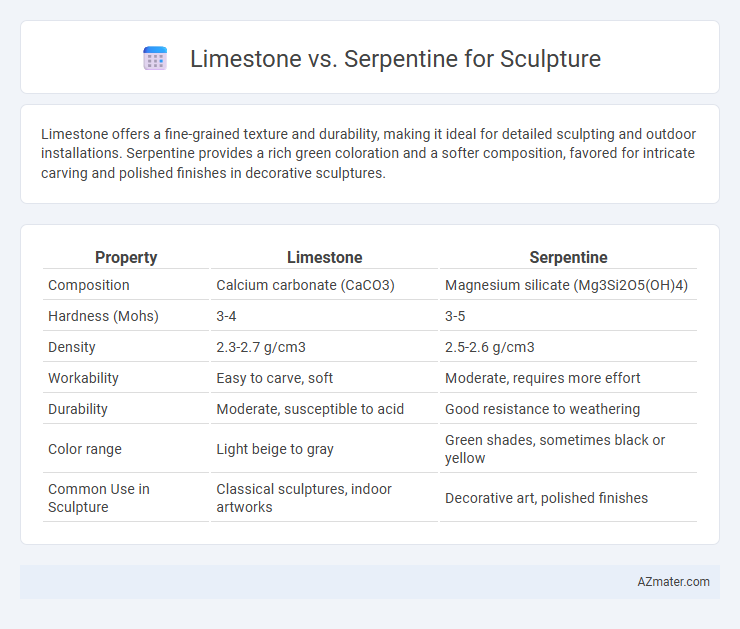Limestone offers a fine-grained texture and durability, making it ideal for detailed sculpting and outdoor installations. Serpentine provides a rich green coloration and a softer composition, favored for intricate carving and polished finishes in decorative sculptures.
Table of Comparison
| Property | Limestone | Serpentine |
|---|---|---|
| Composition | Calcium carbonate (CaCO3) | Magnesium silicate (Mg3Si2O5(OH)4) |
| Hardness (Mohs) | 3-4 | 3-5 |
| Density | 2.3-2.7 g/cm3 | 2.5-2.6 g/cm3 |
| Workability | Easy to carve, soft | Moderate, requires more effort |
| Durability | Moderate, susceptible to acid | Good resistance to weathering |
| Color range | Light beige to gray | Green shades, sometimes black or yellow |
| Common Use in Sculpture | Classical sculptures, indoor artworks | Decorative art, polished finishes |
Overview: Limestone vs Serpentine in Sculpture
Limestone and serpentine offer distinct qualities for sculpture, with limestone prized for its uniform grain, ease of carving, and smooth finish, making it ideal for detailed and classical sculptures. Serpentine, known for its rich green hues and slightly harder texture, provides durability and vibrant coloration but requires more skill to carve due to its toughness and susceptibility to fracturing. Artists choose limestone for traditional, refined works, while serpentine is favored for modern pieces that highlight color and texture contrasts.
Geological Origins and Composition
Limestone, primarily composed of calcium carbonate (CaCO3), forms through the accumulation of marine organism remains such as coral and shell fragments over millions of years in shallow, warm marine environments. Serpentine, rich in magnesium silicate minerals, originates from the metamorphic alteration of ultramafic rocks like peridotite subjected to high-pressure hydrothermal conditions within the Earth's mantle. The distinct mineralogical compositions influence their hardness, workability, and weathering resistance, making limestone softer and easier to carve, while serpentine offers a more durable, dense structure with unique coloration patterns favored in detailed sculptural work.
Workability and Carving Techniques
Limestone offers exceptional workability due to its relatively soft texture, allowing sculptors to easily shape and detail intricate designs with traditional hand tools like chisels and rasps. Serpentine, being denser and tougher, requires specialized tools such as rotary grinders and diamond-tipped bits to achieve fine carving, making it suitable for sculptors experienced in working with harder stones. The porous nature of limestone contributes to its ease of carving but also demands careful finishing to prevent surface erosion, whereas serpentine's toughness provides durability but necessitates a more labor-intensive carving process.
Color, Texture, and Aesthetics
Limestone offers a soft, creamy color palette ranging from white to pale gray, complemented by a fine-grained texture that enables smooth, detailed carvings ideal for classical sculptures. Serpentine displays a rich variety of greens, yellows, and blacks with a waxy, slightly rough texture that gives sculptures a vibrant, organic aesthetic. Artists seeking subtle elegance often choose limestone, while those aiming for bold, naturalistic forms prefer serpentine for its dynamic color and tactile appeal.
Durability and Weather Resistance
Limestone offers moderate durability and weathers relatively well but is susceptible to erosion and acid rain damage over time, making it less ideal for outdoor sculptures in harsh climates. Serpentine, known for its higher density and resistance to weathering, provides superior durability and maintains its polish and structural integrity under varying environmental conditions. Sculptors often prefer serpentine for outdoor applications due to its enhanced weather resistance and longevity compared to limestone.
Availability and Cost Considerations
Limestone is widely available and generally more affordable, making it a popular choice for sculptors seeking economical materials. Serpentine, less common and often sourced from specific regions, tends to be more expensive due to its rarity and unique texture. Cost considerations favor limestone for large projects or beginners, while serpentine is preferred for detailed, high-end sculptures despite higher expenses.
Suitability for Indoor vs Outdoor Sculptures
Limestone is ideal for indoor sculptures due to its relatively soft texture and susceptibility to weathering when exposed to outdoor elements, making it less durable under rain and freeze-thaw cycles. Serpentine offers greater resistance to weather and moisture, making it more suitable for outdoor sculptures exposed to varying climates. Both stones provide distinct aesthetic qualities, but for long-term outdoor durability, serpentine is the preferred choice while limestone excels in controlled, indoor environments.
Notable Sculptures and Artists Using Limestone
Limestone has been favored by renowned artists like Michelangelo, who sculpted the Pieta and David, relying on its fine grain and durability for detailed work. Notable sculptures such as the Sphinx of Giza and many ancient Greek statues demonstrate limestone's versatility and historical significance in monumental art. In contrast, serpentine is less common but prized for its rich green hues, used by modern sculptors seeking unique coloration and texture.
Notable Sculptures and Artists Using Serpentine
Notable serpentine sculptures include works by artist Barbara Hepworth, who valued serpentine's rich green tones and smooth texture for abstract forms. Unlike limestone, which has been favored by Michelangelo for its fine grain and durability, serpentine is preferred in contemporary sculpture for its vibrant color and polish. The unique properties of serpentine allow artists to create dynamic, tactile pieces that contrast with the softer, more porous surface of limestone sculptures.
Choosing the Right Stone for Your Sculpture Project
Limestone offers a smooth texture and is easier to carve, making it ideal for detailed sculptures with fine features. Serpentine, known for its rich green hues and durability, provides a polished finish and is suitable for outdoor installations. Selecting limestone or serpentine depends on the project's detail level, environmental exposure, and desired aesthetic qualities.

Infographic: Limestone vs Serpentine for Sculpture
 azmater.com
azmater.com